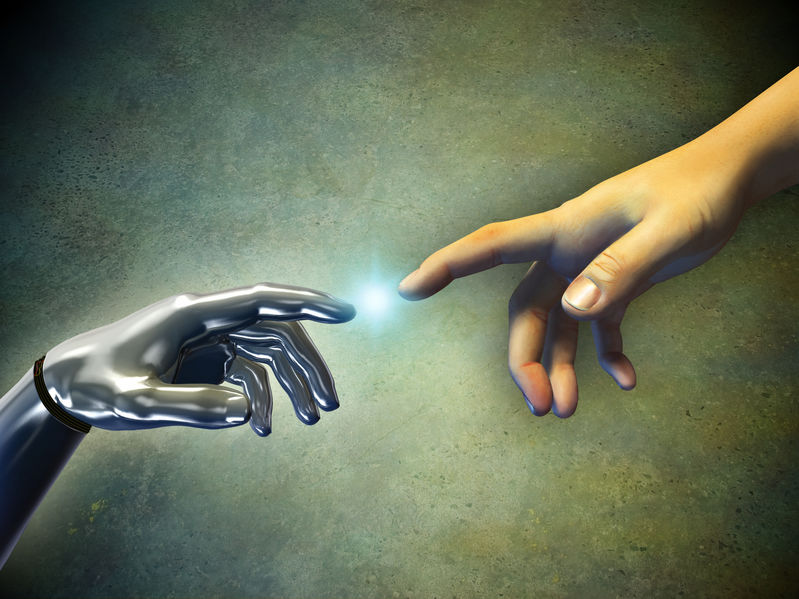AI: Something to Celebrate? Or Fear?
Human hand touching an android hand. Digital illustration.
January 17, 2019
We are living in the beginning of the era of artificial intelligence. Technology is projected to improve and expand exponentially, and many speculate on the brightness — and purpose— of its future.
What does today’s AI look like?
A solid representation of human achievement in technology is “deep learning,” an algorithm found in many electronics. Deep learning, which has been being developed since 2010, uses massive amounts of data to make decisions with superhuman speed, such as recent advances in self-driving cars, facial recognition, and phone cameras that can identify objects and tell whether they’re for sale.
Deep-learning AI has already surpassed the average human ability to recognize images and speech, and even to play computer games. According to an article in Science magazine, the robot “Libratus” defeated four top professional poker players in No Limit Texas Hold’em. The robot was only taught the rules of poker, but it won by breaking the game into more manageable parts and adjusting its strategy as play progressed. This type of AI is able to teach itself and learn at rates way faster than human intelligence.
Potential dangers of AI
Businesses are using AI to do jobs that humans used to perform. For example, many McDonald’s restaurants have implemented self-checkout machines that collect a customer’s order much faster than any human can.
A new report released by McKinsey and Company predicts that by 2030, 800 million jobs will be lost to machines worldwide. But it’s not just fast food clerks that might go extinct; the same report predicts that the U.S. employment rate will fall by close to 100 percent in nearly all office support and physical work jobs.
In a story in Wired magazine, AI researcher and engineer Kai-Fu Lee wrote about AI replacing the need for humans in the workforce. He says that deep-learning AI will always outperform manual and analytical labor if it’s programmed with enough data. Lee also predicts that half of human beings will lose their jobs to basic, or “narrow,” AI.
The reason this job-threatening creation is called “narrow” (and in some circles is referred to as “weak”) is because it pales in comparison to what the next step in AI can do.
How far will automation go?
Google, Apple and other organizations such as Open AI have invested heavily in AI, with achieving “general AI” as their stated goal. General AI goes by a handful of other names, such as “strong AI” and “superintelligence.” It is essentially a machine that can perform any intellectual task that a human can, and which teaches itself as it “ages.”
Artificial general intelligence is a widely debated topic. With its power and promise, many are justifiably skeptical about its safety. Elon Musk, CEO of Tesla and SpaceX and co-founder of Open AI, stated in a somewhat infamous Joe Rogan interview that “with AI, we are summoning the demon.” He said that he tried to get Google to slow down their progress with AI, and he even warned that AI could be humanity’s biggest threat to date. Google has invested billions in AI. Their progress was first landmarked in 2014 when the company purchased the AI organization Deepmind for $500 million.
When asked about a solution to extremely advanced AI at the Code Conference in 2016, Musk gave an answer that caused a ripple over the internet. He said the most feasible way for humans to compete with AI would be to digitally improve their own brains: “If you assume any rate of improvement in AI, we will be left behind…by a lot.”
Musk proposes a new technology called the “neural lace,” a third layer in the brain that will be completely digital to enhance our comprehension skills. He stated that with our constant smartphone and computer use, many of use are already cyborgs. Musk’s neural lace predictions include being able to upload to the internet and send messages using just our mind, without electronics.
Reasons for optimism
The level of fear surrounding AI hasn’t quite reached the magnitude that Y2K garnered, with people protesting in the streets, holding signs and chanting “Repent.” But while many are worried, others completely oppose the idea of general AI being an existential threat.
Steven Pinker is a cognitive psychologist and science writer who offers a much more optimistic view of human beings and AI coexisting. In his book Enlightenment Now, Pinker says that the only credible threat to humanity is mankind’s choosing to not advance technology.
Others share Pinker’s optimism. Victor Belfor, senior vice president of the AI think tank Channel Sales and Business Development at Conversica, believes that technology will greatly improve our lives. “AI has the power to free up much of the time we spend on mundane tasks and has the potential to create a lot of wealth,” he writes in the digital magazine medium.com. He says that the jobs AI will take on will leave us much more room for creativity and that there will be a bigger focus on intellect and arts in the workforce. Belfor predicts a better quality of human life with AI.
But Musk gave this warning at MIT’s AeroAstro Centennial Symposium: “I’m increasingly inclined to think that there should be some regulatory oversight, maybe at the national and international level, just to make sure that we don’t do something very foolish.”



Jose R. Martinez, II (Ray), Substitute Teacher • Jan 31, 2019 at 11:41 am
This article was very interesting and very well written. Thanks Mr. Agard!